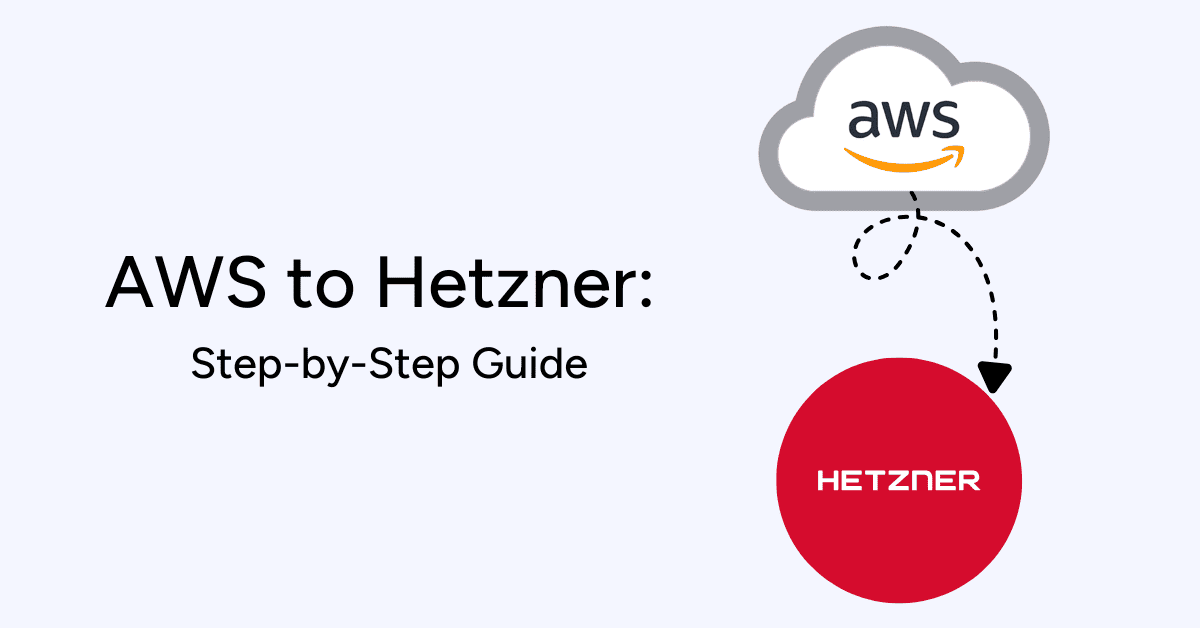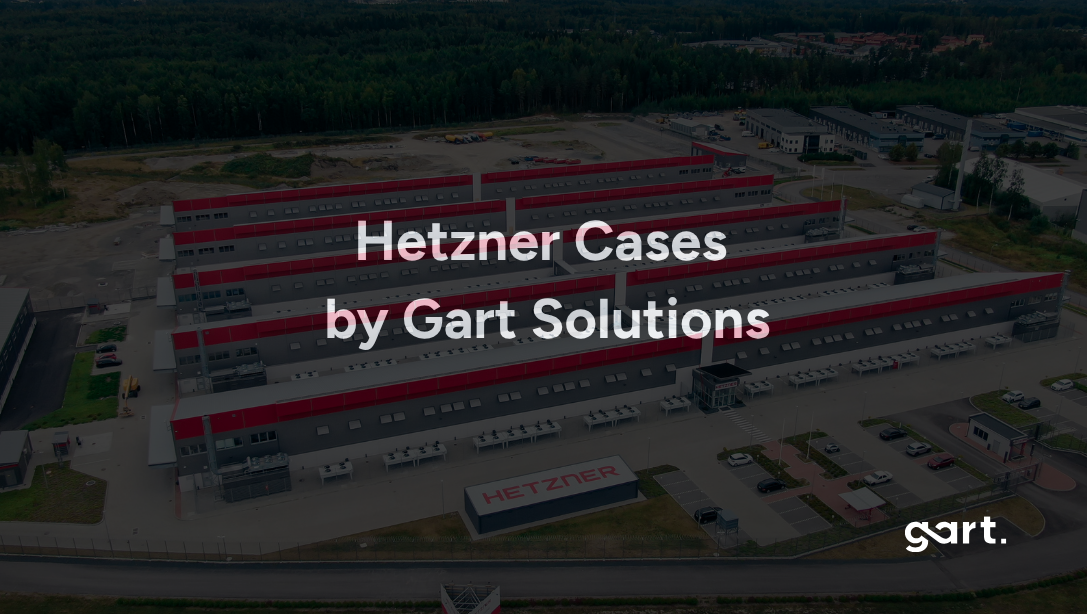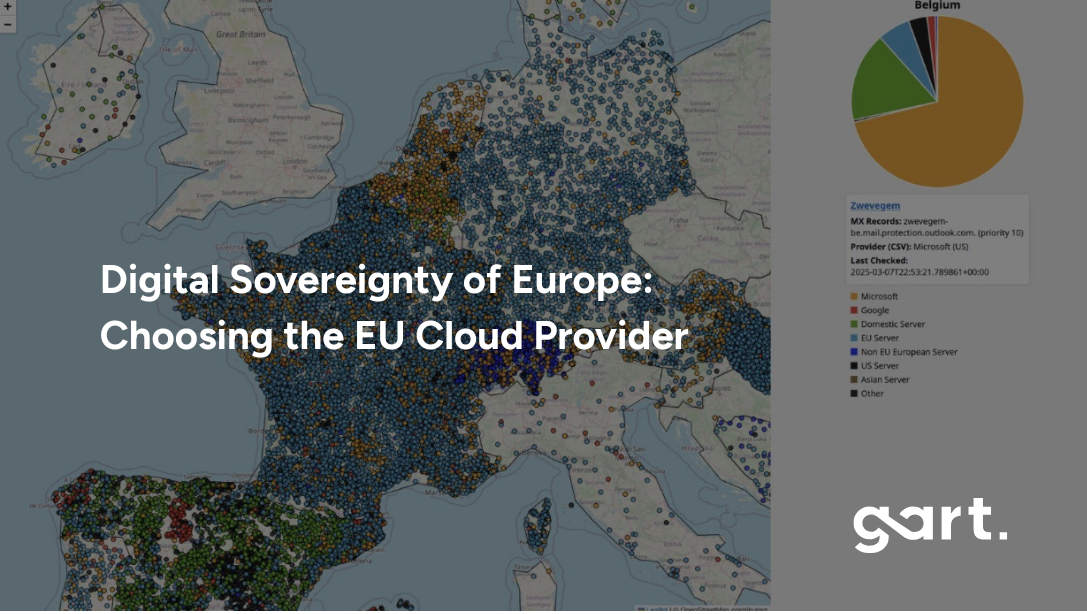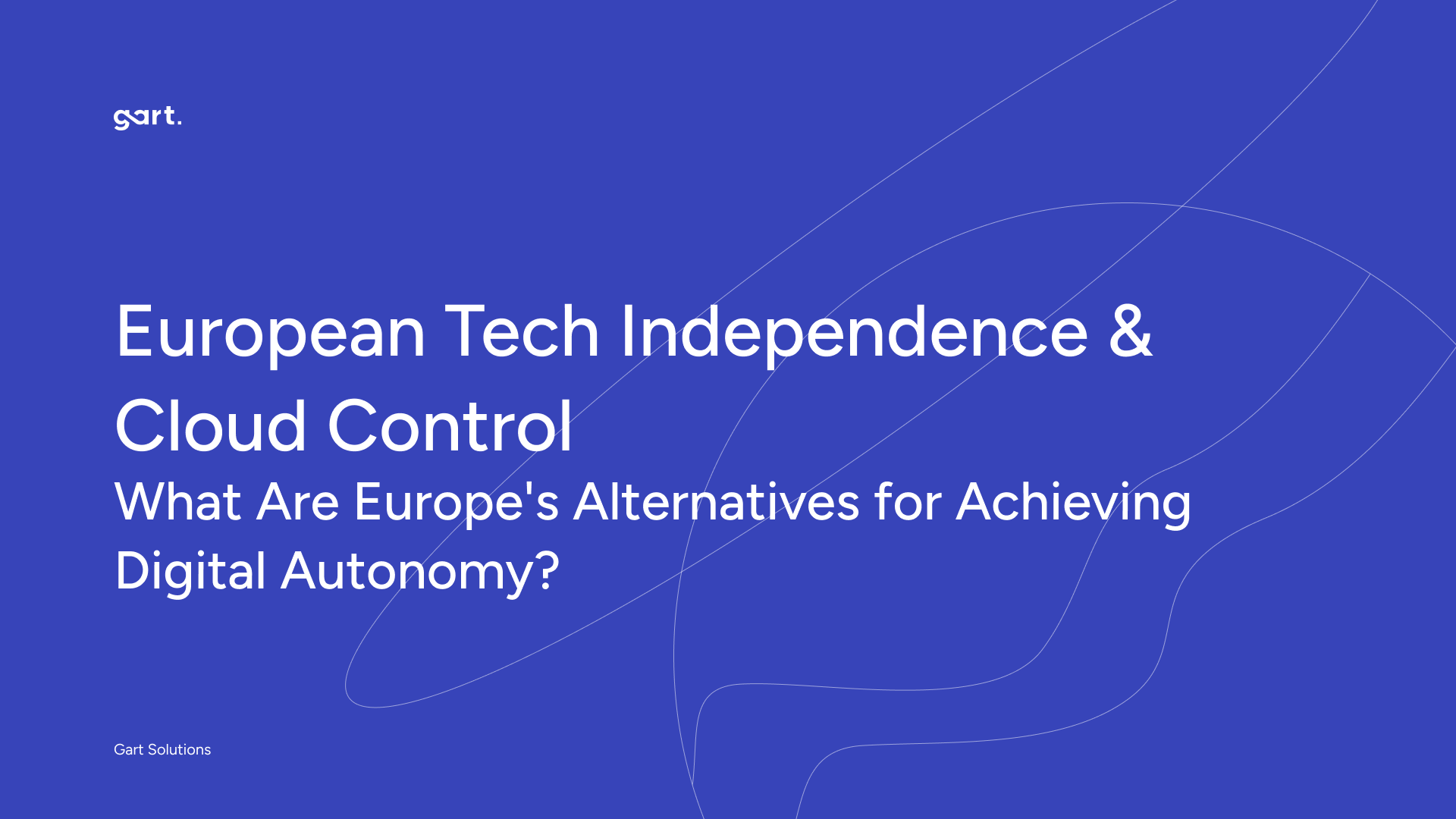- The Rise of Cloud Fatigue — And Why It’s Getting Worse
- Common AWS Cost Traps:
- What Is a Hetzner Cloud and Why to Choose it?
- High-Level AWS to Hetzner Migration Strategy
- 1st: Pre-Migration Phase: Scoping, Auditing, Planning
- 2nd: Building the Foundation in Hetzner (Parallel Setup)
- 3rd. – Data Migration & Dual-Writing (Synchronization Phase)
- 4th. – Cutover / Switch Traffic (Switchover Phase)
- 5th. – Post‑Migration, Optimization & Hardening
- 6th. – Common Challenges & Pitfalls (and How Gart Solutions Helps)
- What Developers Are Saying (Reddit & Hacker News)
- Real-World Migrations to Hetzner: 3 Key Case Studies
- Hetzner vs AWS vs Azure: Feature & Pricing Comparison
- What Makes Hetzner So Attractive for European Teams
- But It’s Not for Everyone: When Hetzner May Not Be a Fit
- Why Choose Gart Solutions as a Migration Partner?
- Example Migration Walkthrough
- Summary & Key Takeaways
- Download the Whitepaper: “Migration from AWS to Hetzner: Step-by-Step Guide to Cut Costs by 90%”
It’s no surprise that tech leaders are searching for alternatives to hyperscalers like AWS. Whether you’re a CTO wrestling with runaway infrastructure bills or a DevOps engineer tired of managing AWS complexity, the reality is the same: AWS is powerful but expensive, and over time, you’re likely paying for far more than you’re using.
That’s where Hetzner enters the picture. A European cloud and dedicated server provider with transparent pricing, high-performance hardware, and no surprise billing. More and more companies — from startups to scale-ups — are migrating from AWS to Hetzner and cutting their cloud bills by up to 90%. This article also explores why businesses across Europe and beyond are migrating to Hetzner. You’ll learn from real-world migration case studies, developer insights from Reddit and Hacker News, and detailed breakdowns of the technical and financial gains teams are experiencing.
In this detailed guide, we’ll show you exactly how to migrate from AWS to Hetzner using a proven, step-by-step playbook. We won’t just say “move your servers” — we’ll show you:
- What tools to use
- What AWS services need replacements
- What pitfalls to avoid
- How Gart Solutions can support your migration with expert DevOps and infrastructure-as-code capabilities
Forget vendor lock-in. Forget mysterious billing surprises. Let’s walk through how to make your infrastructure leaner, cheaper, and more under your control — without sacrificing performance or reliability.
The Rise of Cloud Fatigue — And Why It’s Getting Worse
The pitch of hyperscalers like AWS and Azure was simple: scalable, flexible, and cost-efficient infrastructure for everyone. But in practice, things look very different today.
Here’s what most teams are experiencing:
- Runaway cloud costs with unpredictable billing
- Vendor lock-in through proprietary services and tooling
- PaaS abstraction layers that make debugging harder, not easier
- Data privacy concerns, especially for EU companies
- Opaque pricing models that make forecasting nearly impossible

Common AWS Cost Traps:
- Data Egress Fees: AWS charges up to $0.09/GB for outbound traffic — Hetzner includes 20 TB free per VM, then only ~$1/TB after.
- Managed Services Premium: AWS RDS, ElastiCache, SQS, Lambda all add layers of cost and margin.
- Per-Request Billing: API Gateway, CloudWatch, S3, etc. charge per request — hard to predict and scale.
- Storage IOPS: EBS IOPS fees balloon costs for disk-intensive workloads.
What Is a Hetzner Cloud and Why to Choose it?
Why Hetzner is catching attention:
- Incredibly competitive pricing — VMs start at under €5/month
- Generous data transfer — 20 TB/month included per instance
- EU-based data centers — Fully GDPR-compliant (Germany & Finland)
- Infrastructure over abstraction — You manage the stack
- Native support for Terraform, Docker, Kubernetes (K3s), Ansible, and more

A recent Data-Aces migration revealed Hetzner cut costs by 70–80% across compute and storage alone — and by over 90% in bandwidth fees. That’s a massive savings opportunity.
Below are some real cost savings when moving from AWS to Hetzner with the goal of cutting costs (often cited as “90 %” in real-world moves) while minimizing disruption.
Performance & Pricing Table: AWS vs Hetzner
| Feature | AWS EC2 (t3.medium) | Hetzner CPX21 |
| vCPUs | 2 | 2 |
| RAM | 4 GB | 4 GB |
| Storage | EBS (charged separately) | 40 GB NVMe (included) |
| Monthly Price (EU) | ~$38 + storage | €6.90 (all-inclusive) |
| Bandwidth | Charged separately | 20 TB (included) |
| Performance | Moderate (burstable) | Dedicated vCPU |
Real Cost Savings: From 5x to 10x Cheaper
Let’s model a small-to-medium web app stack:
| Resource | AWS Monthly | Hetzner Monthly | Savings |
| 2x t3.medium VMs | $76 | €13.80 | ~82% |
| 1x RDS db.t3.medium | $75 | Self-hosted DB | ~90% |
| 1 TB S3 Storage | $23 | €2.90 | ~87% |
| 2 TB Egress Bandwidth | $180 | Included | ~100% |
| Total | $354 | ~€20–25 | ~93% |
It’s become especially popular among:
- European SaaS startups
- DevOps-heavy teams tired of black-box services
- Companies pursuing cloud repatriation strategies
- Teams seeking EU-only data residency
These savings are real and repeatable. You just need to plan the migration carefully — and that’s what we’re doing next.
High-Level AWS to Hetzner Migration Strategy
Before diving into detailed steps, it’s critical to pick your strategy. There are three broad approaches when migrating from AWS to Hetzner (or any non‑AWS infrastructure):
| Strategy | Description | Pros | Cons / Risks |
| “Lift & shift” / rehost | Copy your existing EC2 / EBS / file systems over to Hetzner VMs or dedicated servers with minimal re-architecture | Fastest, with less refactoring | Not always feasible (if you use many AWS‑native services), may carry over inefficiencies |
| Replatform / partial refactor | Migrate core (e.g., compute, storage) but rework or replace AWS-managed services (RDS → self‑hosted, Lambdas → functions on servers) | Better performance/cost balance | Requires effort, introduces complexity |
| Refactor / rebuild in Hetzner-native style | Re-architect for Hetzner (VPCs, Docker/Kubernetes, automation) from the ground up | Maximum long-term flexibility and cost control | Longest time, highest upfront risk |
Most real-world migrations are hybrid: you start with lift & shift for some parts, then gradually refactor high-cost or high-risk parts.
One recent migration project publicized their result as “cut 90 %” of AWS costs by migrating to Hetzner + OVH and replicating essential AWS features via Terraform & Ansible. (Hacker News)
But beware — that kind of saving is realistic only if:
- Your usage is steady/ predictable (not huge autoscaling spikes)
- You’re not heavily dependent on AWS-managed services
- You’re ready to take responsibility for operations, monitoring, backups, and reliability
Gart Solutions value is that we help you evaluate that risk, determine which strategy fits you, and execute it.
1st: Pre-Migration Phase: Scoping, Auditing, Planning
Before you touch any server, scoping is everything. This is where your migration succeeds or fails. The first step? Take a full inventory of everything running in your AWS account.
Step 1: Inventory & Mapping
- EC2 instances
- EBS volumes
- S3 buckets
- IAM roles / users
- Security groups / firewalls
- RDS / Aurora / ElastiCache / Lambda
- CloudWatch / logs / alarms
- Route53 zones / DNS entries
- SQS, API Gateway, Cognito, and any AWS-native services
Use AWS Config, Cost Explorer, Inframap, or Gart’s audit suite to pull this automatically.
Step 2: Group by Priority & Risk
Make a matrix:
- Mission-critical vs low-risk
- Stateless vs stateful
- Easy to rehost vs tightly coupled to AWS
Step 3: Choose Migration Approach
- Lift & Shift: Fastest, but carries AWS inefficiencies
- Replatform: Move services but optimize architecture
- Refactor: Best long-term, requires dev investment
Example:
| AWS Service | Action | Hetzner Equivalent |
| EC2 | Rehost | Hetzner Cloud VMs |
| RDS | Replatform | Self-managed PostgreSQL |
| Lambda | Refactor | Docker + cron or serverless |
| S3 | Rehost | Hetzner Object Storage |
| CloudFront | Replace | Cloudflare / BunnyCDN |
Gart Solutions can help design the full architecture, plan migration order, and assess downtime risk per service.
Step 4: Cost Projection Model
Build a spreadsheet estimating:
- Current AWS costs (EC2, RDS, S3, etc.)
- Target Hetzner resources (CPX, CAX, Storage Boxes, Object Storage)
- Estimated total monthly savings
- Migration effort required
Tools like infracost.io + Gart’s cost planner can help model this automatically.
2nd: Building the Foundation in Hetzner (Parallel Setup)
Once your AWS audit is complete and you’ve selected a strategy (lift, replatform, refactor), it’s time to build the new home for your infrastructure on Hetzner. This is the “foundation-laying” phase — your Hetzner infrastructure will run in parallel to your AWS environment during testing and validation.
This approach ensures zero production downtime and gives you time to test everything end-to-end before pulling the plug on AWS.
2.1 Account & Project Setup
- Create your Hetzner account(s). Hetzner uses Projects inside the account for grouping (like “dev”, “prod”).
- Invite users / roles, set up access controls.
- Enable billing alerts, quotas, and usage dashboards.
Gart Solutions helps you bootstrap the account, governance, and security policy from day one.
2.2 Networking & VPC Topology
- Design private networks, subnets, firewall rules (like AWS VPC + security groups).
- Reserve floating IPs (Hetzner analog to AWS elastic IP) for failover.
- Set up NAT gateways / Internet gateways, route tables.
- Decide on cross‑region / cross‑site connectivity (VPN, interconnect).
- Optionally deploy a load balancer (Hetzner’s LB or a custom proxy layer).
In some migrations, teams emulate LB by spinning up CX11 servers with nginx and using floating IPs & automation. This was reported in real-world Reddit migrations. (Reddit)
2.3 Base VM Images & Automation
- Choose your OS base (Ubuntu, Debian, CentOS, etc).
- Harden baseline images (SSH keys, firewall, logging, security).
- Bake images with configuration management (Ansible, Packer) for consistency.
- Deploy staging / test clusters identical to production size but scaled-down.
Gart Solutions can build golden images, implement snapshot & versioning strategy, and automate VM provisioning via Terraform + Ansible.
2.4 Storage & Block Volumes
- Provision volumes / block storage equivalent to EBS.
- Decide volume types (SSD, NVMe, etc).
- Set up disk partitioning, LVM, RAID, or ZFS layers if needed.
- Attach volumes to VMs and test I/O performance, benchmarking.
2.5 Object Storage & S3 Migration Plan
- Use Hetzner Object Storage buckets (S3-compatible). Hetzner’s documentation offers a guide to migrate from another provider’s buckets. (Hetzner Docs)
- Use tools like rclone, s3cmd, MinIO client (mc) for full sync; note custom metadata may be lost except with MinIO client.
- For large data sets, consider multi-part uploads, parallel sync, throttling to avoid saturating network.
Gart Solutions can script and orchestrate bucket-level sync with minimal downtime and consistency checks.
2.6 Database Setup
- Spin up database servers (e.g. PostgreSQL, MySQL, or your DB of choice).
- Configure replication, clustering, high availability, backups, monitoring.
- Optionally put in a delay replica for safety.
- Preload schemas and test with sample data.
Since Hetzner has no fully managed RDS equivalent, you need to treat this carefully. Gart Solutions can help deploy resilient, scalable DB clusters, handle failover, and manage backups.
2.7 Application & Middleware Stack
- Deploy your app stack (containers, runtime, web servers, API servers, caches, etc) in Hetzner staging environment.
- Test end-to-end functionality, integrations, network routes.
- Set up SSL/TLS (Let’s Encrypt, or your own certs).
- Deploy logging, monitoring, alerting stack (Prometheus, Grafana, Loki, ELK, etc).
One migration noted they rebuilt key AWS features (hardening, monitoring, rolling deploys, TLS automation) using Terraform + Ansible. (Hacker News)
2.8 DNS, CDN, & Edge Services
- If you used AWS Route 53, migrate your hosted zones / DNS records to Hetzner DNS (or a third-party DNS if you prefer).
- Set up TTLs low before cutover.
- If you used CloudFront or AWS CDN, evaluate replacing with Cloudflare, BunnyCDN, Fastly, or any CDN of your choice.
- Validate DNS propagation, health checks, and failover behavior.
AWS-to-Hetzner Service Mapping Table
| AWS Service | Hetzner Equivalent / Solution | Notes |
| EC2 | CPX, CAX, or dedicated servers | Similar VM types, better price-perf |
| EBS | Attached volumes | Use NVMe for high-speed I/O |
| S3 | Hetzner Object Storage | S3-compatible with CLI tool support |
| RDS | Self-hosted PostgreSQL/MySQL | Use Ansible + daily snapshot backups |
| Route53 | Hetzner DNS or Cloudflare | Full DNS control, API-accessible |
| CloudFront | Cloudflare, BunnyCDN | CDN options with better pricing |
| Lambda | Docker containers, Cron + Event Hooks | Replace with cron jobs, containers, Nomad |
| SQS | Redis Queue, RabbitMQ, NATS | Use self-hosted queues |
| CloudWatch | Grafana + Prometheus + Loki | Full open-source observability stack |
| IAM | Hetzner API Tokens + Secrets Mgmt | Optional Vault/Keycloak for advanced control |
3rd. – Data Migration & Dual-Writing (Synchronization Phase)
At this point, the Hetzner staging environments are ready. Next, you must bring live data without losing consistency.
3.1 Snapshot / Disk Migration
- For EC2 / EBS volumes, create a snapshot, mount it in AWS, and copy data (via rsync, dd, or file-level).
- Hetzner docs provide a migration recipe: backup data, scp/rsync to new server, restore users, firewall rules, etc. (Hetzner Docs)
- For entire partitions, you can replicate block devices, but be careful with UUIDs, bootloader, etc.
3.2 Database Sync / Replication
- Use database replication from the source (AWS RDS or self-hosted) to the target.
- Use logical replication or sync tools (e.g., pglogical, binlog replication, etc).
- For the final cutover, pause writes or fail traffic to catch up.
- Validate consistency, run checksums, compare counts.
3.3 Dual-Writing / Shadow Writes (if possible)
- If your application allows, implement dual writes (write to both AWS and Hetzner DB) during the migration window.
- Use feature flags, flags to route reads to one side, writes to both, etc.
- This smooths the transition and reduces downtime risk.
3.4 Incremental File Sync
- Use rsync, unison, or incremental sync scripts to keep changing files in sync.
- Use a cron job or a watcher-based incremental tool.
- During final cutover, run a last sync.
3.5 Object Storage Final Sync
- Re-run your s3cmd / mc / rclone sync to flush any changed objects.
- Validate checksums, metadata, and permissions.
3.6 Verification & Smoke Testing
- Validate that data is correct (row counts, file sizes, checksums).
- Run functional and integration tests in the Hetzner environment.
- Monitor logs, metrics, error rates.
- Compare performance between source and target.
Gart Solutions can orchestrate all these sync tasks with prebuilt scripts and verify consistency automatically.
4th. – Cutover / Switch Traffic (Switchover Phase)
With data synced and validation done, now you switch user traffic from AWS to Hetzner.
4.1 Freeze Writes / Quiesce AWS
- Stop new writes on AWS (maintenance window, read-only mode, etc).
- Wait for final replication, flush all queues, and ensure no lag.
4.2 DNS / Floating IP Switch
- Reassign floating IPs or public IPs in Hetzner.
- Update DNS records (lower TTL to speed propagation).
- Use DNS failover, health checks, or weighted routing if available.
- Monitor for propagation errors.
4.3 Enable Traffic & Monitor
- Slowly ramp traffic to Hetzner (e.g., 10 %, 50 %, then 100 %).
- Watch error rates, latencies, resource usage,and logs.
- Roll back if something catastrophic happens (DNS TTL helps).
- Validate stability over several hours/days.
One anecdote from Reddit:
“The migrations … implemented CX11 servers with nginx to do load balancing … floating IP automation was tricky.” (Reddit)
Gart Solutions can provide the automation and control logic for IP switching and traffic cutover to minimize human error.
4.4 Decommission AWS Resources
- Once confident, shut down AWS EC2, RDS, S3 buckets, etc.
- Clean up IAM, snapshots, EBS, autoscaling, etc.
- Keep backups or roll-back snapshots for a grace period.
5th. – Post‑Migration, Optimization & Hardening
The cutover is not the end. You now own full operations and must optimize, mature, and ensure reliability.
5.1 Performance Tuning & Cost Optimization
- Size down over-provisioned VMs.
- Use autoscaling if needed (with scripts / custom logic).
- Tune database, caching, and query performance.
- Monitor usage and right-size volumes, storage classes.
- Optimize network egress and minimize cross-DC traffic.
5.2 Monitoring, Logging, and Alerting
- Implement Prometheus, Grafana, Alertmanager, logging stack (Loki, ELK, etc).
- Monitor metrics: CPU, memory, disk, I/O, network, and application errors.
- Add alert thresholds, SLA-based alerts, and anomaly detection.
- Audit logs, access logs, and enable security monitoring.
In a published migration, they rebuilt AWS features like rolling deploys, auditing, SSH policies, monitoring, and alerting via Ansible & Terraform. (Hacker News)
Gart Solutions can provide this stack out-of-box or adapt your existing one.
5.3 Backup, Disaster Recovery, and DR Planning
- Build a backup strategy: full, incremental, offsite (e.g., backup to object storage, remote region).
- Test restore procedures regularly.
- Spinning up a cold standby in another DC or region.
- Document incident playbooks.
5.4 Security Hardening & Compliance
- Enforce firewall rules, security groups.
- SSH hardening, key rotation.
- Implement intrusion detection, SELinux, audit, and process isolation.
- Network segmentation (public vs private subnets).
- Pen tests, vulnerability scans.
- If you need ISO 27001, GDPR, etc, capture all controls.
The migration to European cloud (Hetzner + OVH) cited that they preserved ISO 27001 alignment using Ansible roles for hardening, alerting, deployments, etc. (Hacker News)
Gart Solutions specializes in security & compliance hardening in such migrations.
5.5 Continuous Improvement & Automation
- Automate deployments (CI/CD pipelines) targeting your new Hetzner environment.
- Use Infrastructure-as-Code (Terraform, Ansible) for reproducibility.
- Add self-healing, scaling, chaos testing.
- Iteratively refine architecture, storage tiers, and caches.
6th. – Common Challenges & Pitfalls (and How Gart Solutions Helps)
Here’s where many migrations get stuck — but with proper attention, you can avoid or mitigate these issues.
| Challenge | Description | Mitigation / Advice |
| AWS-managed services are not present in Hetzner | E.g. Lambda, Kinesis, SQS, managed RDS, EventBridge | Replace with open-source equivalents, host them yourself, or use third-party services. Gart Solutions helps choose and integrate replacements. |
| Network latency and inter-DC instability | Hetzner’s backbone may be less robust across many regions | Avoid cross-DC traffic when possible; architect locality; monitor network; accept in some cases lower reliability. |
| Floating IP (elastic IP) automation complexity | Reassigning public IPs during cutover is tricky | Gart Solutions builds scripts/automation to manage IP reassignment, failover logic, and net rules. |
| Consistency of data during cutover | Replication lag, drift, and race conditions | Use dual writes, quiesce writes carefully, and validate checksums. |
| DNS propagation delays | Slow TTL changes impact cutover | Use low TTL well before, monitor propagation. |
| Operational maturity & support burden | You now manage everything on your own | Gart Solutions can act as your managed services / second-line support and help mature ops. |
| Unexpected performance bottlenecks | Differences in virtualization, disk I/O, and network | Benchmark early, tune, choose right VM types, work with us to profile bottlenecks. |
| Lock‑in to AWS IaC (CloudFormation, CDK) | These are not portable to Hetzner | Migrate to Terraform, rewrite IaC. Gart Solutions helps port your stacks. |
| Team knowledge / expertise gap | Your team may be unfamiliar with Hetzner, managing infrastructure | Gart Solutions can mentor your engineers, share playbooks, and provide operational support. |
What Developers Are Saying (Reddit & Hacker News)
The shift to Hetzner isn’t just hype — it’s backed by growing word-of-mouth among engineers.
From a popular Reddit thread and Hacker News discussions, here’s what developers are saying:
“Hetzner gives me 4x the performance of AWS for less than half the cost.”
“I run my entire CI/CD infrastructure on Hetzner now. It’s faster and cheaper.”
“The simplicity is what makes it powerful. I don’t need all of Azure’s magic, just fast and stable servers.”
“Network somewhat unstable when you operate a large microservice deployment… missing drives, servers that won’t boot … cross region sucks a bit due to network interruptions.”
These quotes reflect a clear trend: developers prefer Hetzner when they want control, speed, and affordability without the lock-in.
That’s exactly the kind of issue Gart Solutions can anticipate and guard against: we can put in redundant paths, failover logic, and monitoring to catch these faults.
Real-World Migrations to Hetzner: 3 Key Case Studies
Let’s break down how real companies moved from AWS, Azure, and legacy systems to Hetzner—what worked, what broke, and what improved.
1. Online Gambling Provider (AWS to Hetzner)

Challenge: AWS costs were spiraling out of control during traffic spikes (especially during major sports events). DevOps complexity slowed deployments.
Solution:
- Dockerized infrastructure
- Hetzner Cloud instances + CI/CD via GitLab
- Manual failovers + internal monitoring
Results:
- 50% lower infra cost
- Faster deployments
- Improved performance during live betting events
2. Media Platform (Legacy + AWS to Hetzner)
Challenge: A hybrid stack with AWS + on-prem hardware was becoming unmanageable. Cloud costs, especially for bandwidth and CDN, were too high.
Solution:
- Static asset delivery via Hetzner + Nginx
- Custom caching and image optimization pipeline
- High-performance VMs for backend API workloads
Results:
- 70% lower monthly spend
- Consistent response times
- Full infrastructure ownership
3. Landfill SaaS App (Azure + Local Servers to Hetzner)

Challenge: Limited scalability, rising Azure fees, and GDPR concerns. Needed to go global without hyperscaler pricing.
Solution:
- Infrastructure provisioned with Terraform
- Self-hosted monitoring, backups, and firewalling
- Docker containers for app services
Results:
- 80% cost savings
- Full GDPR compliance
- Improved uptime + faster deployments.
Hetzner vs AWS vs Azure: Feature & Pricing Comparison
| Feature | Hetzner Cloud | AWS | Microsoft Azure |
|---|---|---|---|
| Compute (4vCPU, 16GB RAM) | €23.75/month | ~$130/month | ~€120/month |
| Bandwidth | 20 TB/month included | ~$0.09/GB outbound | ~€0.12/GB outbound |
| Data Centers | Germany, Finland | Global | Global |
| GDPR Compliance | Native (EU) | Region-specific | Region-specific |
| Managed Services | Minimal (IaaS-focused) | Extensive (RDS, Lambda) | Extensive (App Services) |
| Support | Basic ticketing | Paid support plans | Tiered support options |
| Developer Control | High | Medium | Medium |
| Complexity | Low | High | High |
What Makes Hetzner So Attractive for European Teams
- Price transparency: No more guessing your monthly cloud bill
- Data sovereignty: Native GDPR compliance with data in Germany or Finland
- No lock-in: Infrastructure is yours—no black-box abstractions
- DevOps ready: Works seamlessly with Terraform, Docker, Ansible, GitLab CI/CD
- Fast provisioning: New VMs spin up in seconds
- Simple billing: One invoice, no “billing surprises”

But It’s Not for Everyone: When Hetzner May Not Be a Fit
- You need global region coverage (e.g., US, Asia, LatAm)
- Your team is deeply reliant on managed services
- You lack in-house DevOps or sysadmin experience
- You need enterprise-grade support SLAs or 24/7 NOC

Why Choose Gart Solutions as a Migration Partner?
When choosing a migration partner, you want more than just a “contractor that moves VMs.” Gart Solutions offers:
- End-to-end service — From assessment, architecture, building, cutover, post‑migration hardening, to long-term managed support.
- Risk-aware planning — We perform failure mode analysis, build rollbacks, and stage migrations to minimize downtime.
- Prebuilt modules & templates — For common stacks (web app, API, DB, caching, queueing) we have reusable Terraform + Ansible modules optimized for Hetzner.
- Cost modeling & validation — We help you verify that the “cut 90%” target is realistic for your workload, and guard against surprises.
- Operations transition & training — We upskill your team in the new environment and optionally act as your managed ops partner.
- Security & compliance focus — We bring experience in ISO 27001, GDPR, security hardening, audit controls, so the migration doesn’t compromise your posture.
Gart Solutions is not just moving your infrastructure — we’re enabling you to run reliably, securely, and cost-effectively on Hetzner after the move.
Example Migration Walkthrough
Here’s a condensed example of how a migration might execute:
1. Assessment & planning (2 weeks)
Inventory AWS stack, build dependency map, choose lift & shift for compute + refactor for managed services, cost modeling, roadmap.
2. Build target infra (1 week)
Set up Hetzner projects, VPC, subnets, firewalls, base VM images, object storage, app staging stack, DNS config.
3. Initial data sync (ongoing)
Sync file servers, start DB replication, sync objects.
4. Testing & verification (3 days)
Smoke tests, integration tests, performance tests. Tweak architecture, adjust sizes.
5. Cutover (maintenance window, e.g. weekend)
Freeze writes, run final sync, switch DNS / floating IPs, bring traffic live, monitor.
6. Post‑migration ops (weeks-months)
Tune performance, enable scaling logic, set alerts, harden security, fully decommission AWS.
Actual users report:
“We migrated production in under an hour, once everything was ready; whole prep took days/weeks.” (@rameerez)
“The biggest cost saving was in bandwidth bills.” (Hacker News)
That said, every case is different; Gart Solutions sizes our involvement to your scale and risk appetite.
Summary & Key Takeaways
- Migrating from AWS to Hetzner can yield massive cost savings (some report 70–90 %) especially when AWS bills are heavy for bandwidth and managed services. (Hacker News)
- It’s not just copying servers — you must plan for AWS-native services, network, high availability, DNS, and operational maturity.
- The success lies in rigorous planning, parallel setup, data sync and validation, smart cutover, and post-migration optimization.
- Gart Solutions can serve as your end‑to‑end migration and operations partner, reducing your risk, accelerating execution, and helping you land safely.
- If you follow a methodical playbook and engage expertise (whether Gart or your own), migrating to Hetzner can be practical — not just theory.
Download the Whitepaper: “Migration from AWS to Hetzner: Step-by-Step Guide to Cut Costs by 90%”
See how we can help to overcome your challenges








